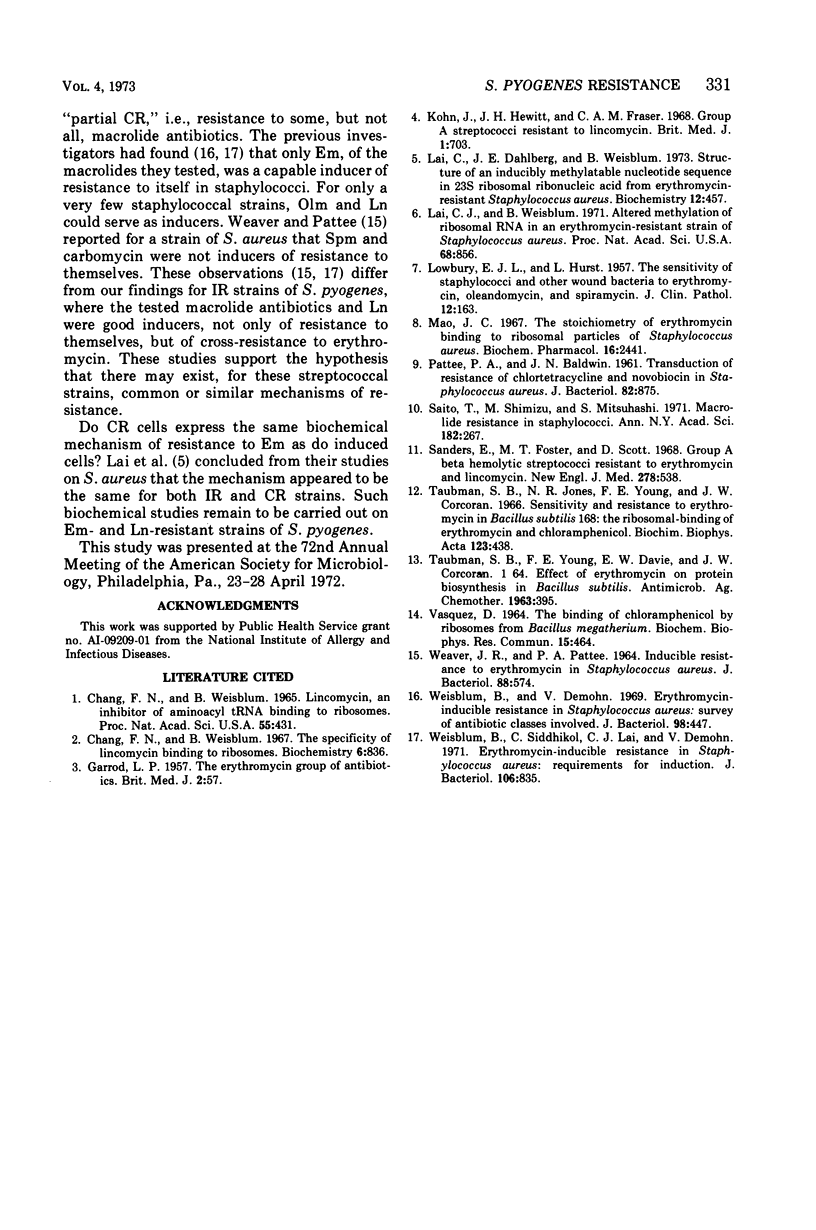Abstract
Studies on erythromycin resistance in strains of group A streptococci indicated that they were comprised of two types: (i) an inducible, resistant type (IR strains) was seen, which manifested immediate logarithmic growth in media containing high concentrations of the drug only after brief previous exposure (induction period) of the organisms to subinhibitory concentrations of erythromycin, and (ii) a constitutive, resistant type (CR strains) which demonstrated, without prior drug exposure, continued logarithmic growth in media containing high concentrations of erythromycin. Subinhibitory concentrations of either chloramphenicol or puromycin, when added to IR strains prior to induction, interfered with their induction by erythromycin. Exposure of CR strains to chloramphenicol did not visibly affect the subsequent growth curve of these strains in media containing high concentrations of erythromycin. In IR strains, resistance to other macrolide antibiotics (oleandomycin, spiramycin, carbomycin, magnamycin) and to lincomycin also was inducible in nature. There was cross-inducibility between erythromycin, other macrolide antibiotics, and lincomycin. CR strains were constitutively resistant to these antibiotics.
Full text
PDF




Selected References
These references are in PubMed. This may not be the complete list of references from this article.
- Chang F. N., Sih C. J., Weisblum B. Lincomycin, an inhibitor of aminoacyl sRNA binding to ribosomes. Proc Natl Acad Sci U S A. 1966 Feb;55(2):431–438. doi: 10.1073/pnas.55.2.431. [DOI] [PMC free article] [PubMed] [Google Scholar]
- Chang F. N., Weisblum B. The specificity of lincomycin binding to ribosomes. Biochemistry. 1967 Mar;6(3):836–843. doi: 10.1021/bi00855a025. [DOI] [PubMed] [Google Scholar]
- GARROD L. P. The erythromycin group of antibiotics. Br Med J. 1957 Jul 13;2(5036):57–63. doi: 10.1136/bmj.2.5036.57. [DOI] [PMC free article] [PubMed] [Google Scholar]
- Kohn J., Hewitt J. H., Fraser C. A. Group A streptococci resistant to lincomycin. Br Med J. 1968 Mar 16;1(5593):703–703. doi: 10.1136/bmj.1.5593.703. [DOI] [PMC free article] [PubMed] [Google Scholar]
- LOWBURY E. J., HURST L. The sensitivity of staphylococci and other wound bacteria to erythromycin, oleandomycin, and spiramycin. J Clin Pathol. 1959 Mar;12(2):163–169. doi: 10.1136/jcp.12.2.163. [DOI] [PMC free article] [PubMed] [Google Scholar]
- Lai C. J., Dahlberg J. E., Weisblum B. Structure of an inducibly methylatable nucleotide sequence in 23S ribosomal ribonucleic acid from erythromycin-resistant Staphylococcus aureus. Biochemistry. 1973 Jan 30;12(3):457–460. doi: 10.1021/bi00727a015. [DOI] [PubMed] [Google Scholar]
- Lai C. J., Weisblum B. Altered methylation of ribosomal RNA in an erythromycin-resistant strain of Staphylococcus aureus. Proc Natl Acad Sci U S A. 1971 Apr;68(4):856–860. doi: 10.1073/pnas.68.4.856. [DOI] [PMC free article] [PubMed] [Google Scholar]
- Mao J. C. The stoichiometry of erythromycin binding to ribosomal particles of Staphylococcus aureus. Biochem Pharmacol. 1967 Dec;16(12):2441–2443. doi: 10.1016/0006-2952(67)90232-8. [DOI] [PubMed] [Google Scholar]
- PATTEE P. A., BALDWIN J. N. Transduction of resistance to chlortetracycline and novobiocin in Staphylococcus aureus. J Bacteriol. 1961 Dec;82:875–881. doi: 10.1128/jb.82.6.875-881.1961. [DOI] [PMC free article] [PubMed] [Google Scholar]
- Saito T., Shimizu M., Mitsuhashi S. The problems of drug-resistant pathogenic bacteria. Macrolide resistance in staphylococci. Ann N Y Acad Sci. 1971 Jun 11;182:267–278. doi: 10.1111/j.1749-6632.1971.tb30663.x. [DOI] [PubMed] [Google Scholar]
- Sanders E., Foster M. T., Scott D. Group A beta-hemolytic streptococci resistant to erythromycin and lincomycin. N Engl J Med. 1968 Mar 7;278(10):538–540. doi: 10.1056/NEJM196803072781005. [DOI] [PubMed] [Google Scholar]
- TAUBMAN S. B., SO A. G., YOUNG F. E., DAVIE E. W., CORCORAN J. W. EFFECT OF ERYTHROMYCIN ON PROTEIN BIOSYNTHESIS IN BACILLUS SUBTILIS. Antimicrob Agents Chemother (Bethesda) 1963;161:395–401. [PubMed] [Google Scholar]
- Taubman S. B., Jones N. R., Young F. E., Corcoran J. W. Sensitivity and resistance to erythromycin in Bacillus subtilis 168: the ribosomal binding of erythromycin and chloramphenicol. Biochim Biophys Acta. 1966 Aug 17;123(2):438–440. doi: 10.1016/0005-2787(66)90301-7. [DOI] [PubMed] [Google Scholar]
- Vazquez D. The binding of chloramphenicol by ribosomes from Bacillus megaterium. Biochem Biophys Res Commun. 1964 Apr 22;15(5):464–468. doi: 10.1016/0006-291x(64)90487-5. [DOI] [PubMed] [Google Scholar]
- WEAVER J. R., PATTEE P. A. INDUCIBLE RESISTANCE TO ERYTHROMYCIN IN STAPHYLOCOCCUS AUREUS. J Bacteriol. 1964 Sep;88:574–580. doi: 10.1128/jb.88.3.574-580.1964. [DOI] [PMC free article] [PubMed] [Google Scholar]
- Weisblum B., Demohn V. Erythromycin-inducible resistance in Staphylococcus aureus: survey of antibiotic classes involved. J Bacteriol. 1969 May;98(2):447–452. doi: 10.1128/jb.98.2.447-452.1969. [DOI] [PMC free article] [PubMed] [Google Scholar]
- Weisblum B., Siddhikol C., Lai C. J., Demohn V. Erythromycin-inducible resistance in Staphylococcus aureus: requirements for induction. J Bacteriol. 1971 Jun;106(3):835–847. doi: 10.1128/jb.106.3.835-847.1971. [DOI] [PMC free article] [PubMed] [Google Scholar]


